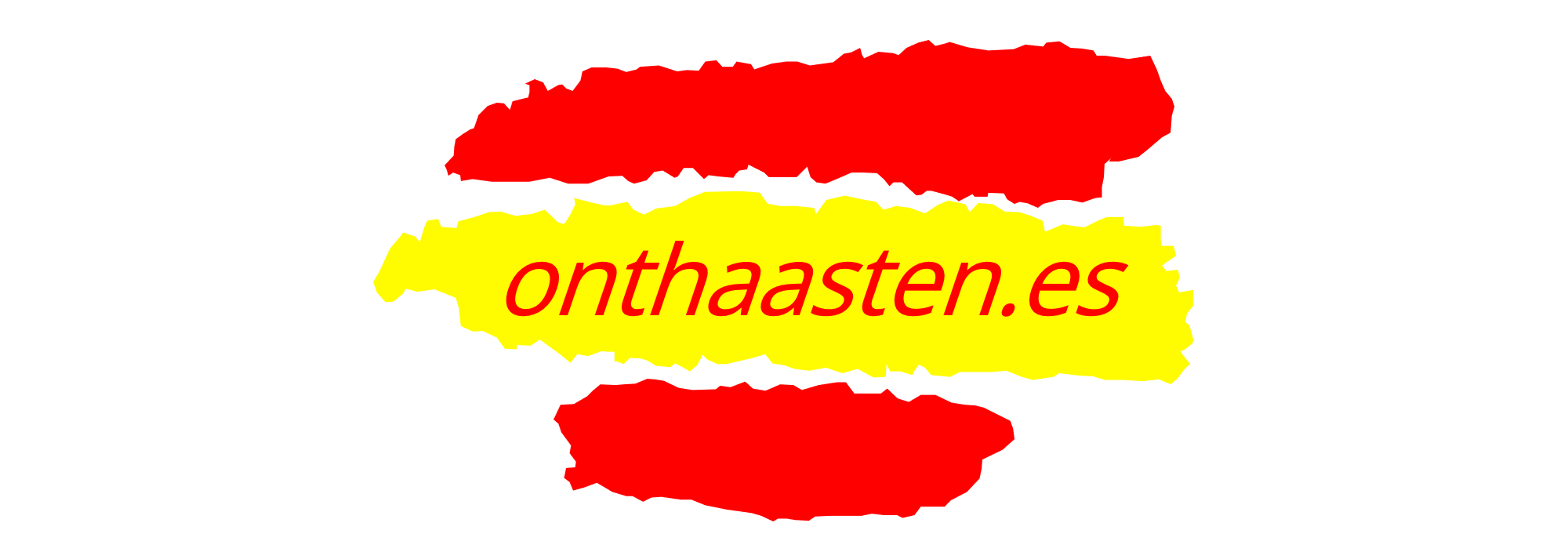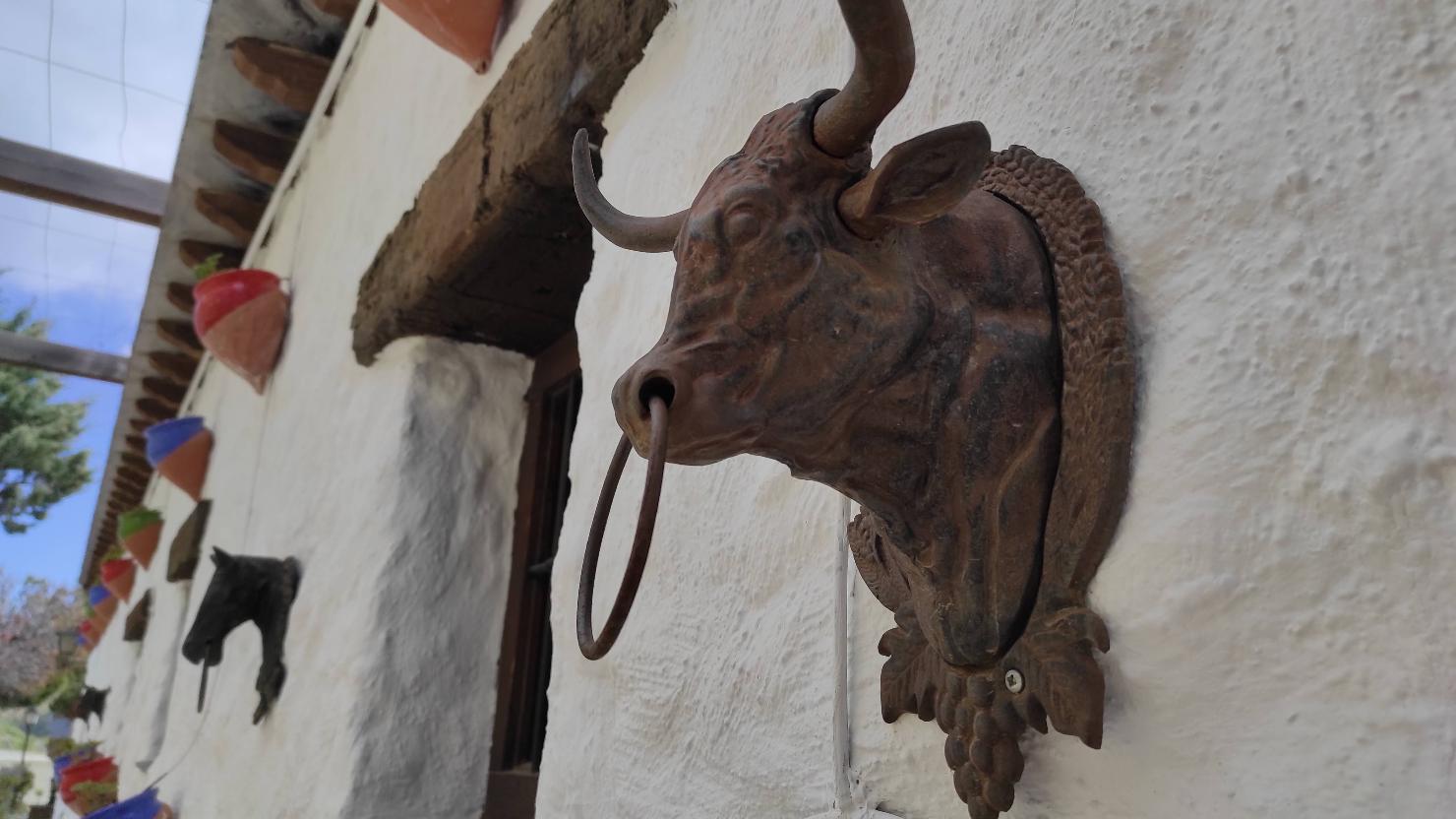
A day in the Alpujarras
This is my first attempt to translate one of my blogposts into English. If you like this post, please like and share it on social media. To follow us building a new life under the Andalusian sun, please subscribe to my future blogposts in English.
Pinos del valle, May 9th 2021, Reijer Staats
I am acting a bit socially awkward with my face mask, during this road trip through la Alpujarra with our neighbour Teresa from Salobreña. I love this region of Trevélez where the jamon is dried in the fresh mountain air and where the famous spring water of the spa town of Lanjarón is bottled.
Despite the two Covid-19 vaccinations that Teresa has already received, we are two households in one car and are therefore obliged to wear "mascarillas". I can smell the greasy potato scent of the two tortillas españolas coming from Teresa's picnic basket. The trunk of the car is also full of jerry cans and empty plastic bottles of 5 and 8 liters, which are to be filled with the spring water from this region later this day. Me: “I am not pulling the mascarilla over my nose." "Me neither!", Teresa responds.
The vault room with private wine lockers in Bodega Cuatro Vientos in the Alpujarras.
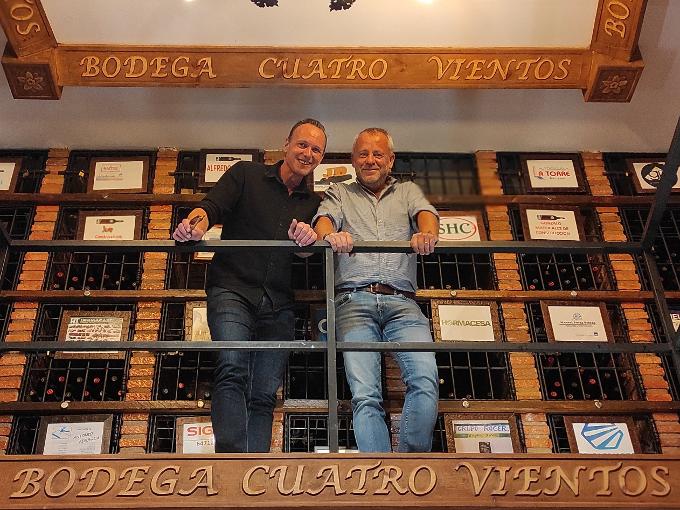
I am enjoying the beautiful mountainous Alpujarras, the curving roads and the snowy peaks of the Sierra Nevada, that contrast with the clear blue sky! I can already see us touring the region in a classic Renault 4 or Citroën 2CV and I am telling Teresa that we are looking for one to buy. She starts to glow and tells us about her ancient blue 2CV, which she unfortunately sold a long time ago. Teresa proudly talks about her trip in 1960 with the Citroën classic of her first French lover from Nantes, all the way from Granada to Paris. It took us a while negotiating about who would be the driver of today’s road trip. But this time, Johan beat our 80-year-old neighbour.
Teresa, sitting in the backseat: "This is a different world!" Meanwhile, we are looking out over the fertile valley with Órgiva in its center, the bohemian capital of la Alpujarra Granadina. Not Bo-chic or Boho Ibiza, but old-fashioned bohemian sixties style and popular with hippies and wannabes looking for “la pura vida”.
The bridge over the ravine at Tablate is one of the most historical places within the borders of our hometown Pinos del Valle. It had been one of the gateways to the isolated Alpujarras for centuries. In the novel “La Alpujarra”, in which writer Pedro Antonio de Alarcón went in search of the last signs of the Arab heritage in Spain at the end of the 19th century, he tells about the eternal battle for this bridge by the Romans, Arabs and Christians. On January 10th, 1569, the Spanish finally defeated the Moors with an army of 2,000 men and 400 horses and moved further to Lanjarón to expel the Moors from the Alpujarras.
El puente de Tablate.
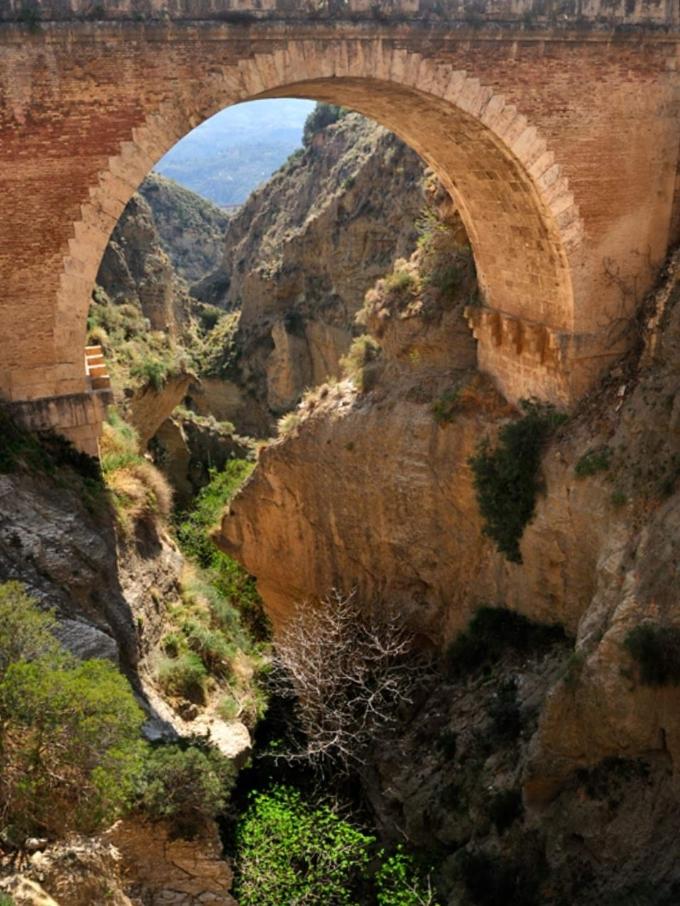
We are driving deeper and deeper into this, once inhospitable, region and the ever-changing landscapes and vegetation, the ravines and the white villages that are so characteristic of the Alpujarras are fascinating me. Teresa, while she herself is being very busy with her phone, asks me to stop chatting and to stop looking over my shoulder all the time, since otherwise I might get a stiff neck and I might get sick. We are gaining a lot of height over the steep winding roads. The light blue facemasks, on the other hand, have now dropped to the level below the chin as we are passing a checkpoint of the Guardia Civil. Somewhat shocked: "Oops!" We are looking at each other with guilty faces. Teresa: "Let's remember this location for the way back."
We have now reached the first stop of the road trip. I am listening to Teresa instructing Johan in a directive manner how to manouvre through the steep narrow streets of the mountain village of Mecina Bombarón. It’s a tidy village with a prosperous look and feel, and it reminds me of Switzerland. Some facades are decorated with red geraniums, the fresh mountain air is tickling my nose through the open windows and I am hearing the sound of running water all around. Johan parks the car at Teresa's Hansel & Gretel house, on the outskirts of Mecina at 1,200 meters above sea level.
Teresa tells us that she hasn't been here since Christmas, so while she is rolling up the blinds in front of the small windows of the house, we are having a talk with her neighbours Yvonne and Jo, who are the owners of B&B Casa la Bombarón. Yvonne tells us about her hiking passion and about the wonderful hiking trails in the Alpujarras that she and Jo have discovered over the past 16 years. Yvonne casually reveals the age of our mutual neighbour and friend, which is a detail I had been too shy to ask for in the past few months.
Teresa in front of her Casa La Casilla in the Alpujarras.
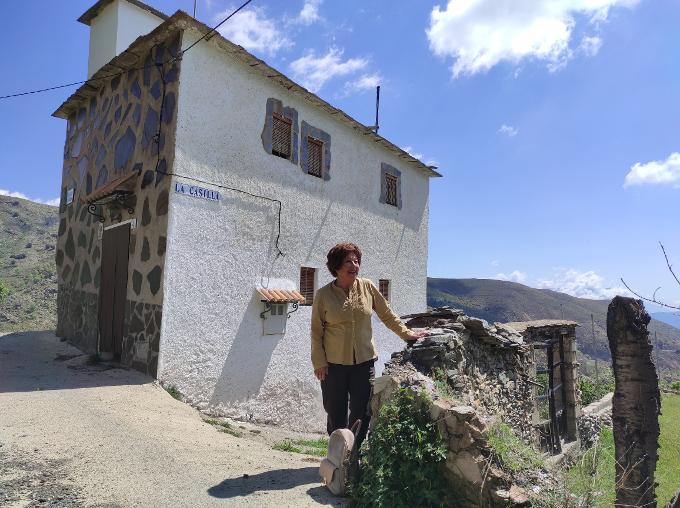
Teresa, shouting from her doorway: "Rayger, Johan! Rayger, Johan! Come, come in!!” I am aware that my name “Reijer”, typically Dutch, is not the easiest for the Brits and Spanish to pronounce. Anyway, Johan and I are invited to come inside. Her hideaway in the mountains has been appropriately named “la Casilla”. In other words: the Box. This box was renovated some 15 years ago.
The amazing beams and slate ceiling immediately draws my attention as we enter the kitchen diner located on the mezzanine. There are French doors opening to a small patio and a staircase down brings us to the former stables, which are now a snug living with a gigantic fireplace and bathroom en suite. “This is where the mule used to find shelter and where the villagers fattened their pig”, Teresa tells us, pointing to the gate through which the cattle were let in and out. On the upper floor she shows us a second bedroom with en-suite bathroom, which is tiled with the beautiful mosaics from her historic family home in Salobreña. The view from the roof terrace is amazing. While Teresa is about to give her hideaway a thourough cleaning in preparation for a prospective buyer's viewing, she sends us off to enjoy a walk through the chestnut woods.
This beautiful view at 1,200 meters is for sale. Write me an email and I'll bring you in contact with Teresa.
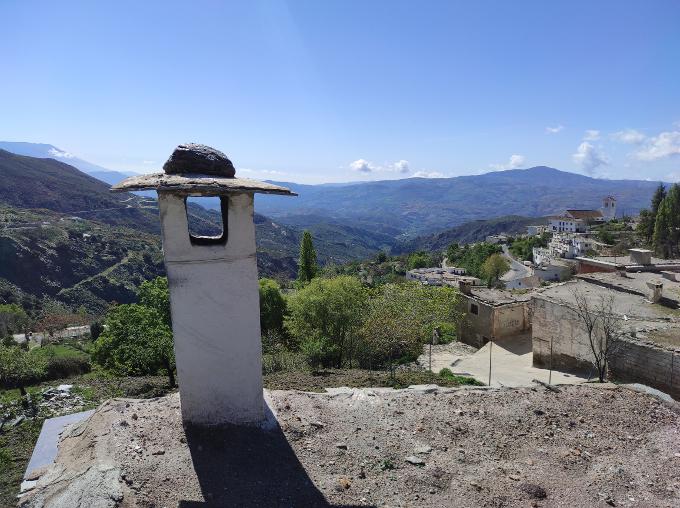
Johan prefers to walk to the “barrio bajo”, the lower village where we just passed the local bar, in stead of walking through the campo. We seat ourselves on the sunny terrace while the village life is passing us by. A masculine peasant woman suddenly appears on the scene and proudly shows us a gigantic egg from one of her chickens. According to her, this extremely large egg should have three yolks. After sitting lazily in the sun for an hour and paying € 4.40 for 2 café cortado and 2 café con leche, we walk back up the steep streets and pick up Teresa for the second part of the road trip to our lunch venue.
While passing the local village church, Teresa tells us that it used to be a mosque in which the Moors were herded together and murdered during the Inquisition. Ildefonso Falcones wrote a beautiful historical novel about the Morisks in the Alpujarras. “The hand of Fátima” tells the story of the Muslims who were forcibly converted to Christianity and had had enough of the legal inequality, the looting and humiliation by the Christians and who rebelled against them.
Johan gives a signal just before passing the curve in the road where the Guardia Civil checkpoint was before. We are quickly pulling the face masks back over our mouths and noses. The law enforcement officers have already left however and are most likely on their way to lunch with their own families too.
The vineyards of Bodega Cuatro Vientos at about 1,150 meters above sea level.
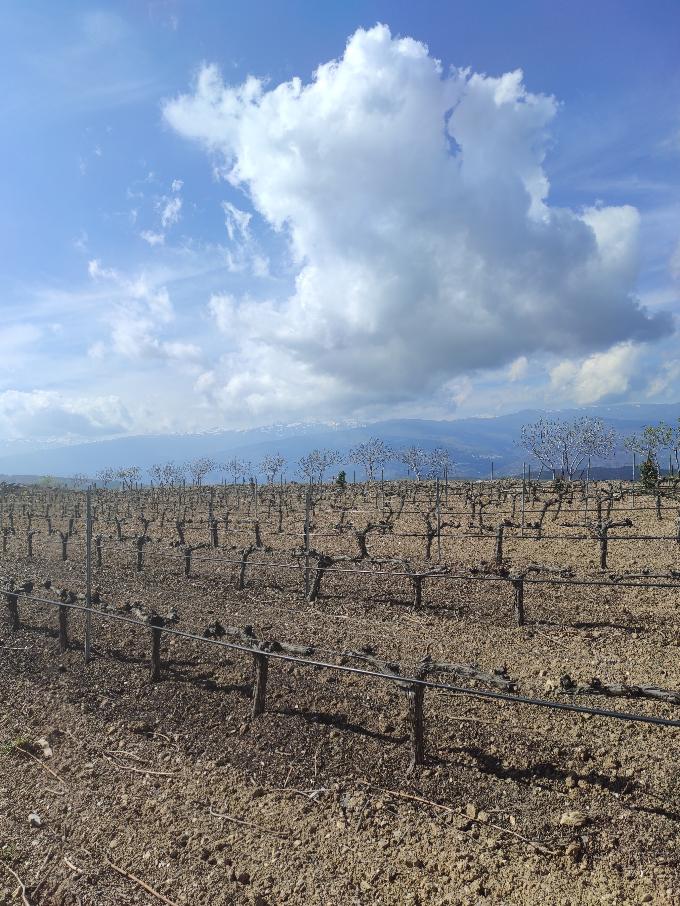
We are leaving the upland Alpujarra de la Sierra, the remote region where the British author Gerald Brenan lived between 1920 and 1934. In his autobiography “South from Granada” he tells us about his experiences in a Spanish village, deeply hidden in this mountain range. We are now driving through the valley to the lower mountain ridge of la Contraviesa on the south side, where the highest vineyards in Europe are located at up to 1,400 meters altitude above sea level.
It was here, 40 years ago already, on the winding and poorly maintained mountain roads of the Ruta del Vino to Bodega Cuatro Vientos, where Teresa drove with a rusty old Landrover and a trailer full of Cabernet Sauvignon grapes, harvested from her vineyard above Almuñecar, to have the grapes processed into bottles with precious fermented grape juice.
Vinologist Paco, the 10-year-old son of the wine family back then, opens the large electric gates of the impressive wine farm 40 years later. Johan and I are witnessing an affectionate reunion of two amigos. I have not seen an embrace this warm-hearted since the beginning of the pandemic. Paco is opening the bodega today just for us and Teresa's three friends: Incarma, Laura and Juan.
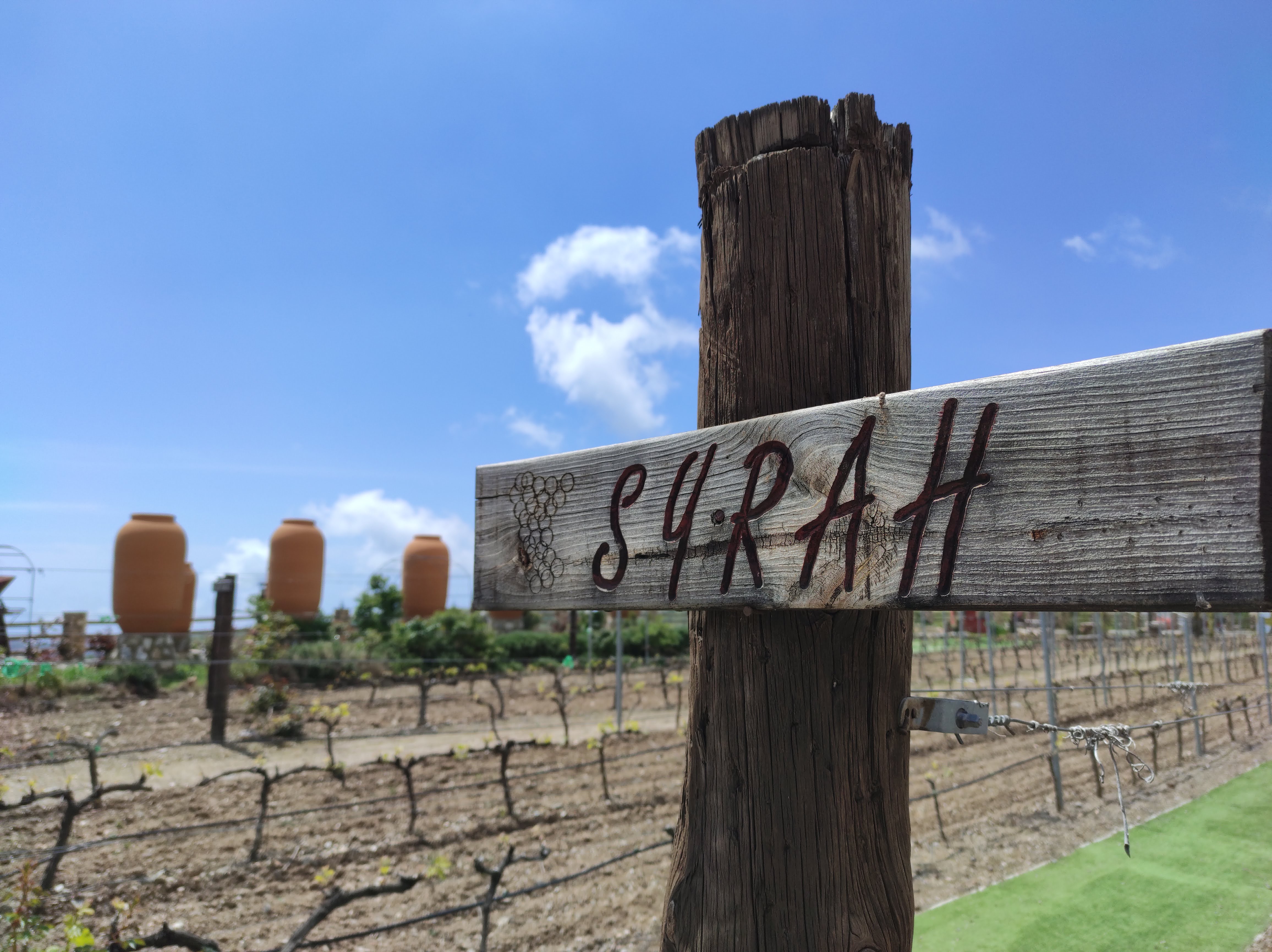
Johan and I take a stroll through the fields with the different wine grape varieties, when we’re suddenly hearing Teresa's voice from afar: "Rayger, Johan! Rayger, Johan! Come, come in!!” Entering the bodega, the friendly and patient Paco lets us taste a white blend of Chardonnay and Vijireiga, a forgotten grape variety typical of the region. Paco proudly tells us that the blend received an award a day earlier.
The few sips of the almost orange coloured fluid with the applicable name “Naranja”, hit me hard right away! But no worries, since Johan is the driver of today’s road trip. When Teresa's friends have also arrived and the gate is immediately closed to other parties interested, we are descending the lazy stairs down to enter the cool wine cellars for a historical tour.
Teresa in the historical cellars of Bodega Cuatro Vientos.
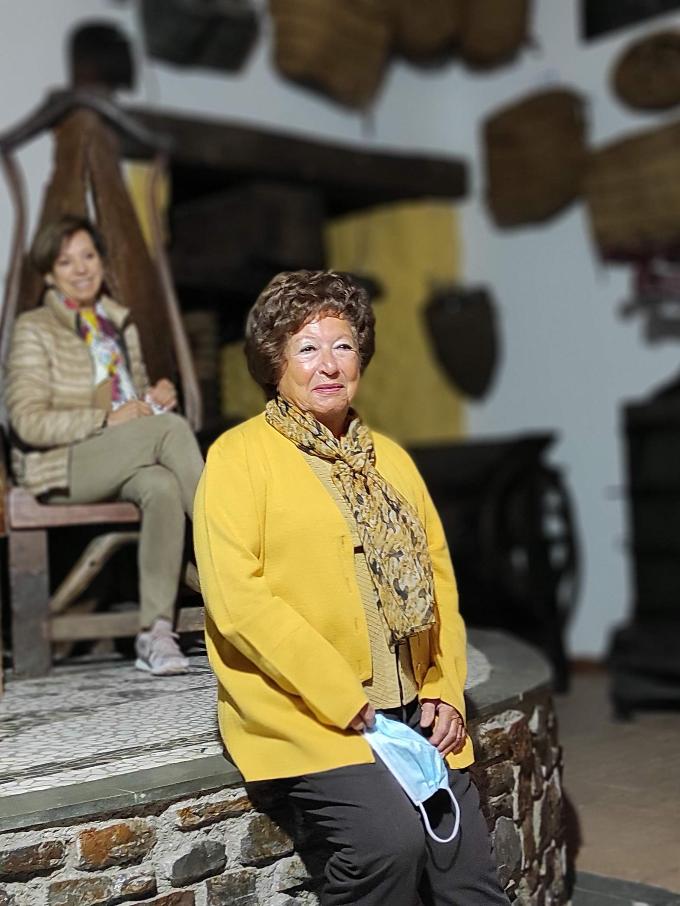
In a somewhat dark corner of the cellars, we are reaching a beautiful vault room with private wine lockers, where, a long time ago, Teresa stored her small wine stock. Ever since then, her padlock has been hanging on one of thelockers with her name on it. Every now and then she returns to take some bottles home, since the climate at her property on the coast is far too hot and humid to keep the wine drinkable for a long time. Teresa: "When I die, I want my ashes to be burried here in my private locker, hahaha!"
The tortillas españolas, the bread from the Sunday bakery and a variety of fresh cheeses, jamon, sausages, vegetables and other specialties from the Alpujarras are taken out from the picnic baskets and all are displayed on the wooden table in the center of the vault room. Connoisseur Paco takes the matching wines from the shelves. Wine and food pairing in special company and accompanied by Paco’s hilarious wine stories. I am being taught some Spanish swearing when the municipal politicians of Salobreña become the topic of conversation: “polla” and “gilipolla”. Teresa tells me to quickly forget these words!
A few short Arabic sounding Flamenco fragments of the expressive Laura are rewarded with a special bottle of red by Paco.
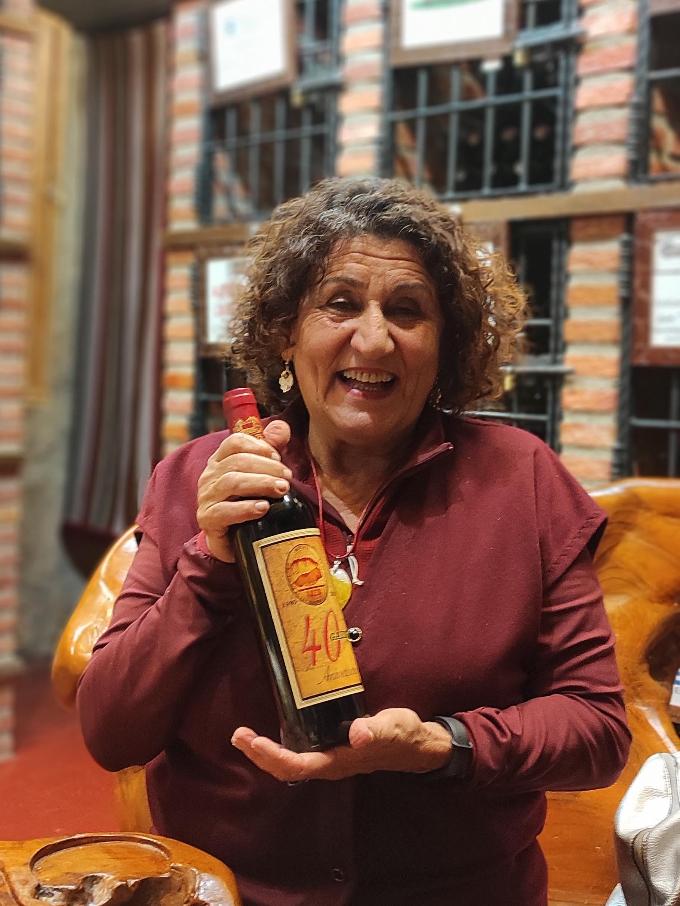
“I love the porc meat.” Teresa recalls memories of the “matanza del cerdo”, the slaughter of the pig, which had been an important unifying tradition in the Alpujarras until very recently. It took place every year in winter months and Teresa experienced the tradition often up close as a child. I am a bit shocked and, as an animal lover and a loyal sponsor of animal welfare organizations, my face is showing some disgust.
I am aware of my hypocrisy as Teresa responds to the expression on my face: "But why? This was the culture of the people and it’s sad that it has disappeared. Nowadays everything takes place behind the closed doors of the industrialized livestock agriculture and nobody has any idea of what’s going on there. Back then it was a ritual of families and a feast of the women, who sang their songs for days and days. Nothing of the pig would go to waste and it would provide food for a local family for a whole year.”
However, the pig’s despair is on my mind also. The Eternal optimist Chris Stewart, who retired a little too early as a Genesis band member at the age of 17, wrote about his experience with the “matanza del cerdo” in “Driving Over Lemons”, the first novel in his hilarious trylogy about building a new life as a sheep farmer in the Alpujarras. The specific chapter of the book that describes the killing made quite an impression on me. In the meantime I am starting to feel like a book reviewer, discussing the most important works which are set in the Alpujarras. Possibly, a new title could be added to this list soon. I am pleased that Teresa is already introducing me to her friends as " Rayger ", her writer friend who will put her memoirs on paper.
After a tasty wine food paring of Cabernet Sauvignon Marqués de la Contraviesa 2009 from Bodega Cuatro Viento and chocolate, after filling the jerry cans and bottles with natural spring water and after picking fresh mint from the garden of the wine farm, we are now driving back to Salobreña to drop off Teresa at her home. We are feeling somewhat tired but satisfied, and fortunately our car now smells of delicious fresh mint instead of the greasy potato scent of the tortillas españolas.
All wine and food is consumed!
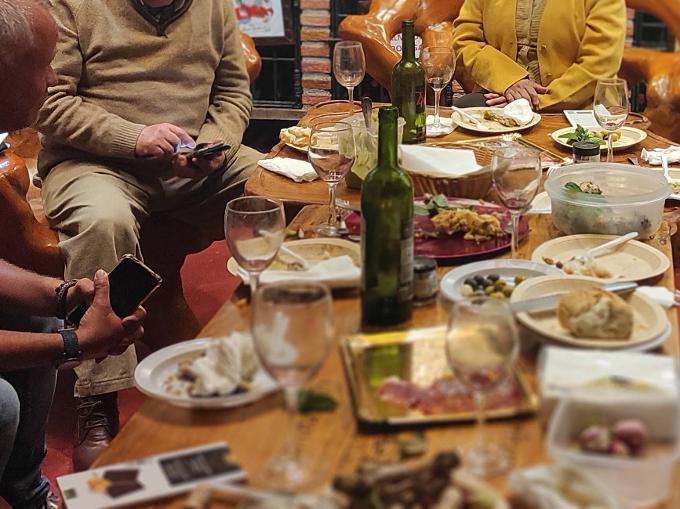
We have been seeing quite a lot of the beautiful province of Granada lately during our search for a French classic: a vintage car that will make these kinds of road trips an even more nostalgic experience! In the center of Granada Capital, an artistic elderly couple is stepping out of their sleek red Quatrelle. He is wearing an alpine cap and she is having a Petit Chien Lion dog on the leash. They are casually parking the Renault “Cuatro latas” (four cans) in front of a popular coffee bar, while we are inspecting an almost depreciated yellow Renault 4 in the poorly lit parking opposite.
Our search also brings us to Guadix, a provincial town north of the Sierra Nevada, known for its quaint cave houses which are inhabited by gypsies. A car enthusiast, in the nearby village of Dúrcal in our own Lecrín Valley, is opening the doors of his old carpentry factory with, to our suprise, at least 30 historical cars: Citroën 2CV delivery vans, Seat 500 classics (the Spanish version) and Mercedes classics from the 1970s. They are all under a thick layer of dust and are waiting to be rehabilitated and sold. The restored Renault 4L, which we had in mind on this Friday afternoon is absolutely beautiful.
However, some locals never cease to amaze me. Why would someone advertise a car if it does not yet have the valid ITV inspection to make sure it meets the roadworthiness standards, when the car’s battery is completely empty and it’s parked in a dark, unlit garage? Or when the car is locked in by 30 other classics and has nowhere to go or when it is completely dirty with the waste from the owner’s last visit to the McDrive still on the back seat?
We finally succeed in our quest in a suburb of Granada where we buy a vintage Renault 4-F6 on an early Sunday morning, Every Sunday morning from now on, we are going to therapeutically relax in eighties style in our own “Voiture Boulanger”.
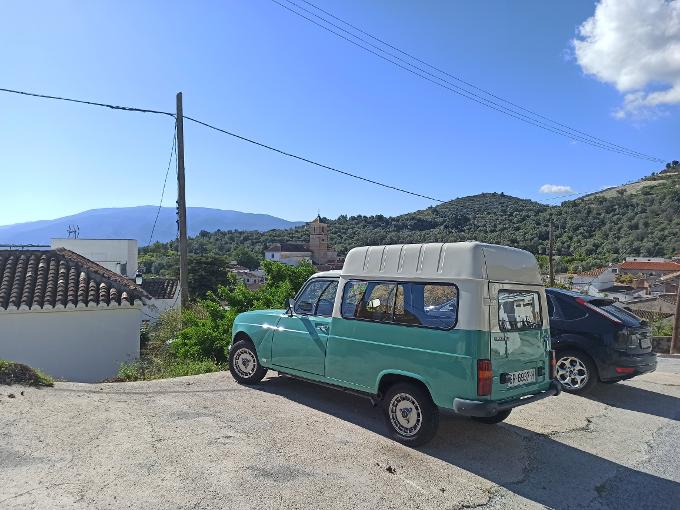
I will have much more opportunities to enjoy all the wonders that Granada, the Sierra Nevada, the Costa Tropical, la Alpujarra and the Valley of Happiness have to offer. I have decided to say goodbye to my full time work as an HR Advisor for Boston Scientific's HR Service Center, partly to create more time for our activities related to the renovation of our fifth project in the valley and to the rental of our (holiday) properties, but mainly to start putting Teresa's life story on paper. I have worked for this client from Granada based Alight NGA with great pleasure and I am looking back on a great time with funny colleagues in an international and motivated team. My last working week has now arrived. A new phase in our Andalusian emigration adventure begins.
Johan and I are now receiving the first bookings for the summer of 2021 and our family, friends and followers are sending us sweet messages saying they have not forgotten us and will visit us as soon as it is allowed. We can't wait!
Un abrazzo from the Valley of Happiness
Johan and Reijer
